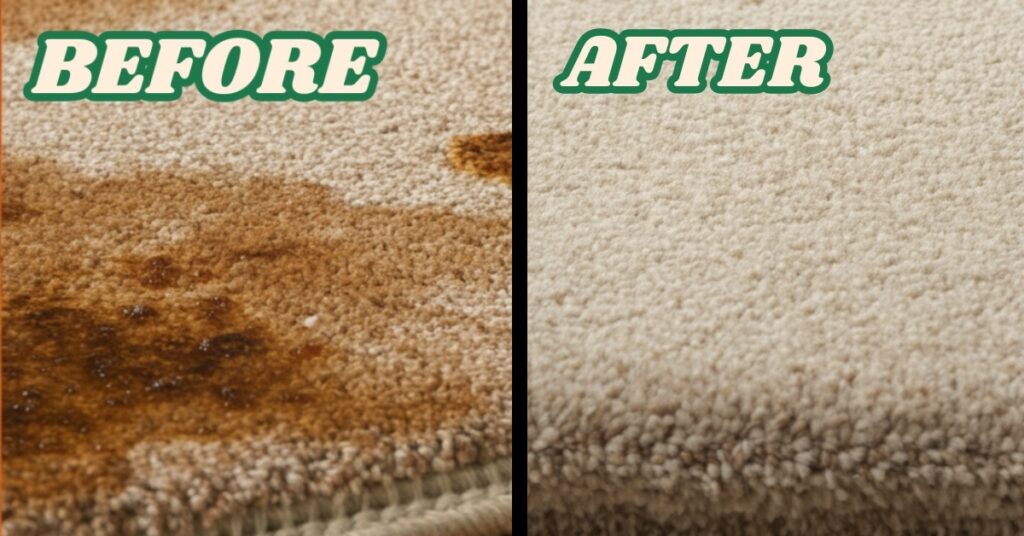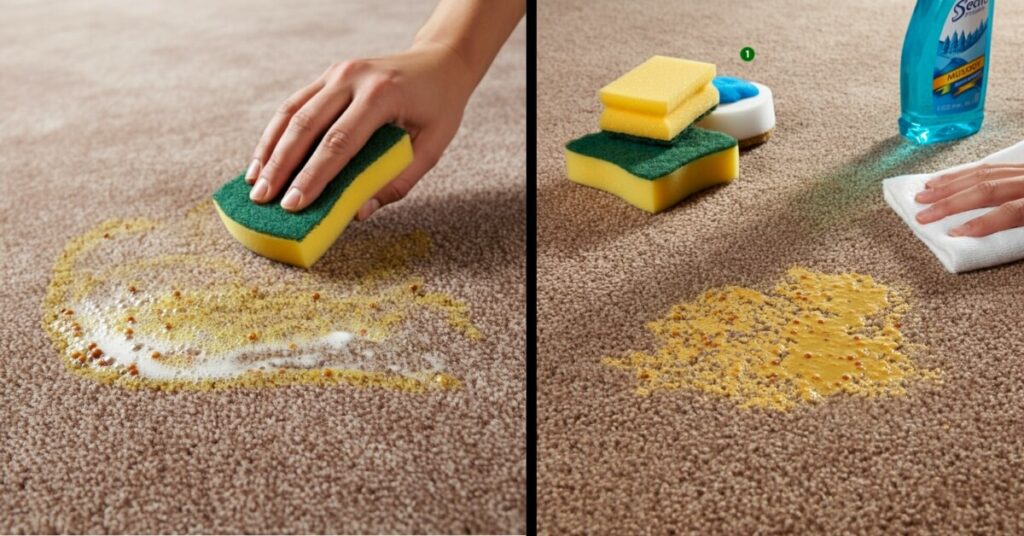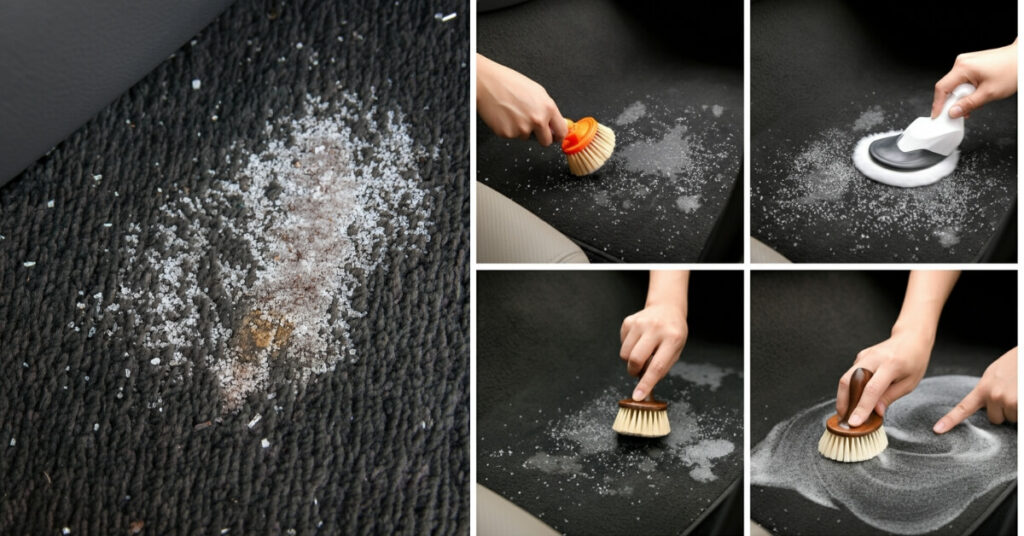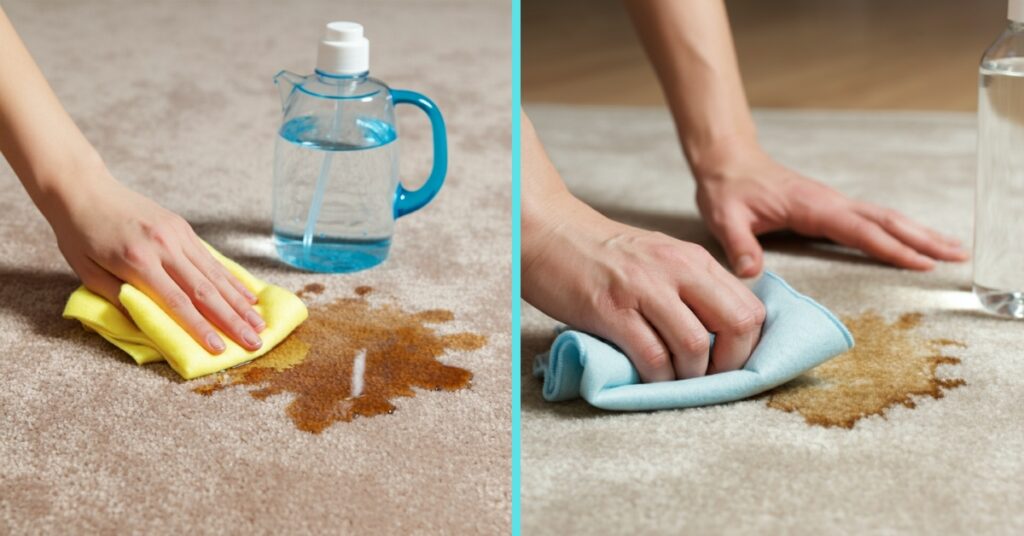As an Amazon Associate, I earn from qualifying purchases.
Bleach stains are tough, they remove color permanently. But don’t worry, there are ways to hide the damage. How to fix bleach stain on carpet? Try dyeing the spot, using a carpet repair kit, or blending with fabric markers to restore the look. Quick, simple, and totally doable. With the right tools, you can make the stain nearly invisible. No need to replace the entire carpet over one small mishap.
The first step is accepting that the damage caused is, in fact, permanent. Now, grab your fancy white gloves because, along with the damage, drastic approaches can help lessen the impact. This guide will help you understand the causes of bleach stains, provide methods for repairing or concealing the damage, and share preventative tips for the future. With the right steps taken, dealing with a bleach stain is simpler than it may seem!
Why Are Bleach Stains Different?
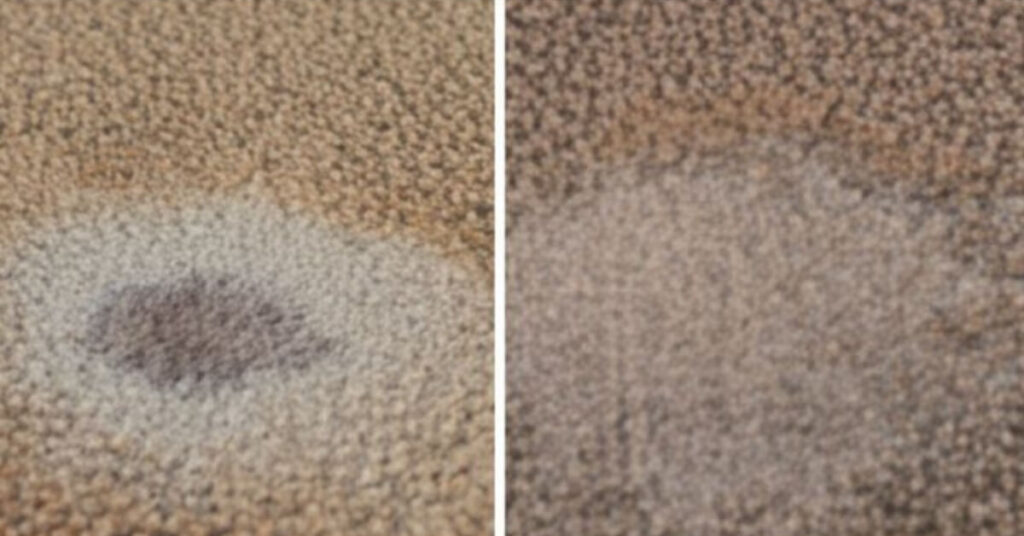
Compared to conventional stains, bleach stains change the carpet differently. Most spills, such as food, wine, or mud, are made up of materials that release some form of residue onto carpet fibers. These stains are dealt with by removing or breaking down the residue to restore the carpet’s clean appearance.
No Residue to Clean
Different from other stains, there is no scrub residue left behind, and bleach stains. Rather, color subtraction occurs, leaving behind white, yellow, or orange splotches.
Chemical Sensitivity
Carpets that are exposed to bleach suffer color and texture changes that can be permanent. Carpets can lose color and weaken the fibers, such that some places become stiff and other spots feel fragile.
Color Patchiness
Larger size spills lead to exaggeration of uneven staining, whereby some areas lose more color than others. To make their appearance uniform, blending techniques are required.
Invisible at First
The carpet may dry to reveal a pale patch. Homeowners, therefore, get puzzled and later shocked. The answer may be that there is no way to clean bleach stains, but their appearance can be altered with specific techniques. Understanding this distinction helps manage expectations while avoiding disappointment.
Steps on How to Fix a Bleach Stain on Carpet (Completing Cleanup Procedures)
There are ways to remedy the consequences of a bleach spill even when the damage is done. This is often the case with carpets, which are expensive to install and maintain. DIY loops exist to help hide or remedy damage carpets encounter after bleach spills
Step 1: Stop Fresh Spill from Widening Bleach Stain on Carpet
It is always best to minimize damage, especially when caught at an early stage. You can follow the “Blot, Do Not Rub” method. To prevent liquid from spreading further, wipe with a clean, white cloth or a paper towel by gently pressing. Remember not to scrub or rub, as this only makes the situation worse.
Step 2: Expose to Bleach
Even after blurring it, the area to be blurred still needs to be cleaned to prevent excess bleach from going through the process. To expose, spraying bleach will do. Saturating the air with relatively low water cools the exposed spot, which aids in stopping the bleaching procedures without excessive discoloration.
If you have a wet/dry vacuum available, using it alongside rinsing can be more efficient in removing leftover cleaning products from the carpet’s surface. Multiple brief rinses and blotting are better than one thorough soak.
Step 3: Apply a Carpet Repair Marker
Carpet repair markers work best for small blemished carpets by restoring the color effectively. These markers come in varying shades which makes it easy to select the right one.
- Use a marker that is closest to your carpet color.
- Use the marker on the affected area meticulously so that the edges are seamless.
- Let it dry, then determine whether more layers are required to blend in fully.
Tip: keep them handy because they are useful for quick repairs, and storing them will prepare you for any future accidents. Often, a more realistic finish comes from blending two shades of markers: a base color with a highlight. Always apply it in natural lighting to properly assess your work and make adjustments. Test your chosen shade on a hidden area first for confidence.
Dyes and stains can be removed by applying fabric dye. This method can be very effective for restoring your carpet’s look since dyes come in different colors.
Step 4: Apply Fabric Dye For Larger Stains
- Ensure you follow the manufacturer’s mixing directions.
- Apply the dye on the stained area using a cotton swab.
- Blend the harsh lines using soft-bristle brushes. Gentle round brushes can also be used for this.
Pro Tip: If you have a colored carpet, test the dye on a less visible patch first to ensure it doesn’t stand out. You can create the best results by mixing custom shades.
Homeowners who complete a successful job dyeing carpets note that applying the dye to thin layers is more effective than applying it to thick layers. This technique helps mimic the original depth of the carpet and prevents the need for new patches.
Step 5: Blend and Brush the Area
For a seamless, natural finish, dab the center with a small brush to blend the color with the surrounding fibers. This step is particularly important for larger stains, as it helps prevent the newly colored area from standing out.
After the dye or marker dries, carefully fluff the carpet pile with a fork or carpet rake. Texture in addition to color is just as important when replicating something. If your carpet is looped or patterned, gently sculpting the fiber position may help further hide the repair.
Step 6: Think About Carpet Patching for Severe Damage
In areas with concentrated stains that cannot be dyed out, patchwork may be a better option. Here’s what to do;
- Remove the stained section and replace it with remnants or leftover pieces of carpet you no longer use, as long as they match.
- Secure the piece using double-sided carpet tape or adhesive.
- Brush the edges to soften the outline and make it less distinct.
This approach is a permanent solution to extensive bleach damage. If you don’t have any excess carpet saved from the installation, look in closets or under furniture for a piece you can cut up, or consider buying a small remnant from your local carpet store.
Pro tip: To make a patch cut, always use square or rectangular shapes instead of circles or complicated shapes. Make sure that the direction of the carpet is aligned in a way that the pile stands the same way as the surrounding area.
Step 7: Air Dry Completely
After completing the repairs, ensure the carpet is completely air-dried before walking on it or placing anything on top of the repaired area. Moisture left in the fibers will result in long-term issues like mold or changes to the texture of the carpet.
Placing fans around the carpet to create good airflow will speed up the drying time. Avoid placing any heat sources or exposing the carpet to sunlight, as this will result in the carpet fading before the color can set. You can learn how to dry carpet after cleaning from our proper guideline article.
Best Methods to Repair or Hide Stains from Bleach
Based on the severity of the damage done to the carpet due to bleach, here are a few ways this can be fixed:
1. Getting The Carpet Dye Kits
Restoring color on larger stains can easily be done by purchasing a carpet dye kit. These kits are great because they come with a variety of dye shades so you can mix and match colors to get the best match for your carpet.
Recommended Product: Rit All-Purpose Dye Kit easy to use, and the color selection is simple. Each kit comes with instructions and charts that do shades and custom mixing, which can rejuvenate areas on carpets or refresh an entire section of carpet.
2. Carpet Repair Markers
These markers are especially designed for touch-up in carpets and come in various shades. They are ideal for small repairs due to their affordability and ease. Recommended Product: Mohawk Carpet Touch-Up Pen perfect for small discolorations. It is best to keep a few different shades to easily deal with small repairs as they happen.
3. Professional Carpet Re-Dyeing
If you find yourself not confident with the DIY methods, it would be best to hire a professional carpet technician. They can perfectly re-dye the damaged area to match perfectly.
Most professionals utilize turbochargers and color-matching technology for seamless blending, which is particularly beneficial in busy, visible areas. This technology can address color match challenges and achieve results that appear brand new.
4. Carpet Patch Replacement
Patching is an effective solution for severe or large-scale bleach damage. A professional installer can seamlessly replace the damaged section. A professional’s skill can ensure a neat and seamless blend between the old and the new, which is quite significant for patterned or textured carpets.
5. Area Rugs
Adding an area rug can conceal the damage if repairing the stain is not an option. It effectively hides a carpet stain and also prevents further damage.
Recommended Product: nuLOOM Area Rugs. These area rugs are durable and stylish, which makes them an excellent addition to any space. Apart from covering mistakes, rugs help enhance the overall look of the room and add a cozy feel. A rug can serve as an everlasting, practical solution or as a temporary measure while you wait for a repair.
Read Next: Bissell Little Green Multi-Purpose Portable Carpet Cleaner Review | Is It Worth It?
Tips to Stop Future Bleach Accidents
Accidents happen, but taking simple steps can help minimize damage to your carpet. The following suggestions can help you protect your carpet.
Avoid Using Bleach Near Carpets
Keeping bleach-based cleaning products away from carpeted areas could work wonders. If only used in tiled areas, the risk can be minimized.
Switch to Color-Safe Alternatives
For cleaning purposes, consider switching to color-safe alternatives. These do not pose the same risk to carpet fibers, and many of them work exceptionally well in disinfecting without danger.
Rinse Spill Immediately
In the event of a spill, rinse the area immediately with cold water. In the case of laundry detergent containing bleach, even a slight amount can cause unintended bleaching.
Keep Cleaning Supplies in a Safe Place
To prevent spills, keep bleach products completely out of reach. Places close to children and pets should be avoided, because a curious poke is all it takes to cause carpet damage.
No Bleach Zone Instruction
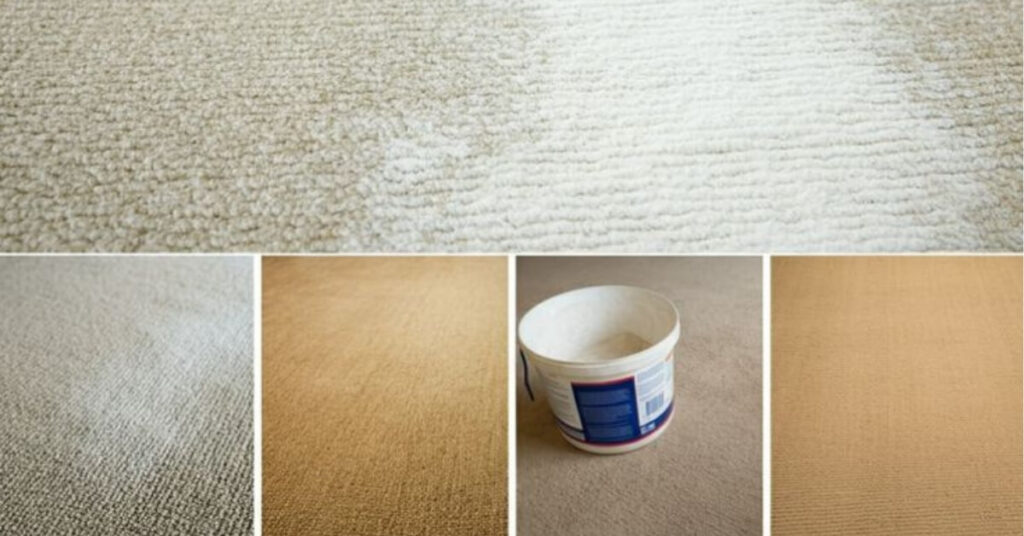
You can consider implementing “No Bleach Zones” for rooms that contain carpets. This would help avoid any unexpected incidents while cleaning. The strategies as mentioned earlier can help protect carpets from unintended bleach damage, while promoting safer cleaning practices for the entire family. “
Conclusion
Disaster from bleach stains can be fixed effectively with the right procedures. While bleach stains are indeed permanent, there are various ways to mend your carpet’s appearance, such as repair markers and fabric dyes, or professionally re-dyeing and patching.
Act swiftly, employ gentle restoration methods, and don’t hesitate to think outside the box when it comes to color blending or texture restoration. With patience and a keen attention to detail, even larger or multi-tone carpets can be restored.
FAQs
1. Can I dye a bleach stain back to the original carpet color?
Absolutely, with fabric dyes or professional carpet dye kits you can achieve a close match to the original color of your carpet. Just remember doing a patch test first to ensure an accurate color match. Exercise patience, and take your time layering or blending for the spot to fully disappear.
2. Do bleach stains get worse over time?
As long as the affected area is attended to promptly, bleach stains will not get worse. However, the damage may gradually get worse if, over time, the bleach makes the fibers more susceptible to damage. Foot traffic tends to cause more wear and tear in the bleached areas, and in such cases, patching those areas may be the best permanent fix.
3. Are carpet markers permanent?
While they may become less effective over time in high-traffic areas, carpet markers are a great long-term repair. The longevity of a repair depends on many factors, like the quality of the marker, the level of use, and the carpet pile height.
4. What if the bleach turned my carpet orange?
The chemical reaction some carpet fibers have with bleach causes the orange discoloration. This happens more often in synthetic carpets. To balance the orange and make it closer to the area surrounding it, you may need to use a dye kit with yellow and red tones. If you can’t fix it yourself, a color matching professional might be able to rectify it better.
5. Can a professional fully fix bleach stains?
Professionals often achieve close to perfect results using re-dyeing and patching techniques. Experts can work on difficult stains or multi-colored carpets and picky fibers, still achieving consistency, thanks to their specialized tools and dyes. When it comes to valuable carpets or wall-to-wall carpets, getting them repaired by an expert can be worth the expense if it means a guarantee for peace of mind and perfection.
As an Amazon Associate, I earn from qualifying purchases.

